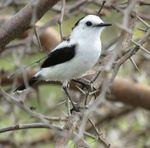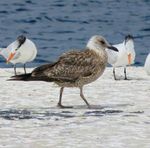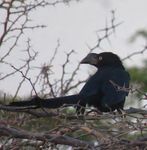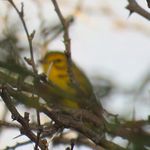New Bird Records for Bonaire 2016-2017
←
→
Page content transcription
If your browser does not render page correctly, please read the page content below
New Bird Records for Bonaire 2016-2017
By Peter-Paul Schets
The island of Bonaire has achieved worldwide north of Bonaire, is an especially important breed-
recognition for its rich and diverse marine life, ing and roosting site for the yellow-shouldered
but the island is rapidly gaining momentum amazon, along with Washikemba-Fontein-
as a birdwatchers paradise. Recent estimates Onima. Gotomeer and Pekelmeer provide vital
put Bonaire’s bird population at more than 210 breeding grounds for the Caribbean flamingo
species, with a great variety of terrestrial and (Phoenicopterus ruber), Bonaire’s flagship bird.
sea bird species. While some species reside year- Globally and regionally important numbers of tern
round on Bonaire, many are migratory species also nest at Pekelmeer (Common tern (Sterna
that stop on the island on route to or from North hirundo), Sandwich tern (Sterna sandvicensis),
and South America. Least tern (Sterna antillarum)). Klein Bonaire is
also an important breeding site for terns, notably
The island acts as a sanctuary for many rare or least terns. Lac Bay supports many shorebird
endangered bird species, such as the Yellow- species, including seven species of heron.
shouldered amazon (Amazona barbadensis),
known locally as the “Lora”. Birdlife International Over the past two years - from January 2016 to the
has identified six International Bird Areas (IBAs) on end of 2017 – at least eight bird species have been
Bonaire: Washington-Slagbaai National Park, Dos recorded for the first time on Bonaire. One other
Pos, Washikemba-Fontein-Onima, Klein Bonaire, species awaits final identification. The record of a
Lac Bay and Pekelmeer Saltworks (see table 1). 10th species could not be validated due to a lack of
IBAs are areas recognized as globally important footage. This article describes these first records.
for the conservation of bird populations according The discovery of new bird species for the island
to a number of set criteria. Bonaire’s IBAs provide is extremely exciting and shows that there is still
vital breeding and foraging grounds to species much to discover about Bonaire’s biodiversity.
with a high conservation priority. Dos Pos, in the
Oilbird, photo by: © Paulo Bertuol
BioNews 11 - Content ... 11 12 13 14 15 ...1. Lesser black-backed gull (Larus fuscus) 2. Pied water-tyrant (Fluvicola pica) 3. Dickcissel (Spiza americana) 4. Oilbird (Steatornis caripensis)
Plaza Resort Bonaire Sewage plant LVV terrain near the Sewage plant Kralendijk
On January 6th 2016 Peter-Paul Schets took pictures While birding after a working day on January 8th Just after arrival on Bonaire on October 2nd 2016, The discovery of an Oilbird on the night of January 4th
of a first year Lesser black-backed gull. The bird was 2016, Schets found a Pied water-tyrant at Sewage Schets went to the LVV fields next to Sewage plant 2017 was spectacular. While having dinner at a restau-
resting on a small raft at Plaza Hotel, close to the plant. This was the first record of this species for the to see if there were any migrating birds. Apart from rant in Kralendijk, Lauren Schmalz and Quirijn Coolen
beach, amidst a number of Laughing gulls, Royal ABC-islands. A snippet in BioNews (January 2016) was Fork-tailed flycatchers, Caribbean martins and a saw it flying to and from a palm tree. It appeared for
terns and Brown pelicans. This species had been dedicated to this record. This bird was seen by various Prothonotary warbler he found two Dickcissels. This several consecutive nights in the same garden, feeding
recorded several times on Aruba but so far never on birders until the end of March 2016. Most often it was species, a migrant from North America, had been on palm nuts. The Bonaire Reporter published an arti-
Curaçao and Bonaire. Schets saw the same bird that feeding in one of the dead trees in the biggest pond of recorded several times on Aruba and Curaçao but so cle, including a great picture, on this exciting record.
week on two more days, on different places. Later it Sewage plant. far never on Bonaire. On October 4th, Schets recorded
became evident Bonaire resident Sipke Stapert had another three Dickcissels at Sewage plant and six The Oilbird is a nocturnal bird that lives in the South
photographed this bird already in December 2015 at Quite surprising, on January 14th 2017 visiting birder months later (1 April 1st 2017), Sieben took a picture of American mainland and on Trinidad. This species was
Pekelmeer (see Birds of Aruba, Bonaire and Curaçao Marco Tijs recorded a Pied water-tyrant at exactly the one Dickcissel at the same location. only seen once before on the ABC-islands, namely in
by J.V. Wells and A. Childs Wells, 2017). same spot. His pictures show a bird with a brown back, 1976 on Aruba. It is reddish-orange in color with white-
indicating a female. Again several birders saw this The Dickcissel is a sparrow-like bird that inhabits spotted plumage, big eyes and a small but heavily
The Lesser black-backed gull breeds in Europe but species during the first months of 2017, all at the same grassland habitats where it forages for seeds and hooked bill (del Risco et al, 2011). Throughout the day,
can be found in North America year-round, with some pond of Sewage plant. The last record made was on insects. While most Dickcissels congregate in huge the Oilbird hides in large numbers in dark caves. It uses
going as far south as the Caribbean. It nests in colonies May 8th 2017 by Herman Sieben. Intriguingly, photos flocks in migration and on their tropical grassland echolocation to navigate in the dark. It is a frugivore
on the ground or occasionally on cliff ledges and even made by Schets on April 23rd 2017 clearly show a male wintering grounds, some individuals venture far from and consumes lipid-rich fruit primarily from the laurel
on the rooftops of buildings. Its diet is omnivorous Pied water-tyrant, which means more than one bird their normal range (Kaufman, 1996). Both sexes have (Lauraceae), torchwood (Burseraceae), and palm
and includes fish, eggs, rodents, berries, seaweed and was spotted. a grayish head with a white chin and yellow stripe (Palmae) plant families (del Risco et al, 2011), and will
insects (Kaufman, 1996). As its name suggests, this above the eyes (Wildscreen Arkive, 2018). Males are travel quite far from its cave to forage. Some Oilbirds
medium-sized gull has a dark grey back, as well as The Pied water-tyrant is a common resident bird in larger than females and have only during breeding are known to migrate seasonally away from breeding
distinct yellow legs and a yellow bill with a red spot. northern South America and occurs on Trinidad as season a distinct V-shaped patch on their yellow sites in search for food (del Risco et al, 2011).
Lesser black-backed gulls can be found in a number well. This small flycatcher species inhabits marshy chest. Throughout the breeding season, males are
of coastal habitats including estuaries, harbours and wetlands and mangrove swamps where it feeds on very territorial and will vigorously defend their nesting
lagoons (Wildscreen Arkive, 2018). insects (Neotropical Birds Online). Nests are built by and foraging grounds from other males (Wildscreen
both the male and female on tree branches near or Arkive, 2018).
over water. Adults are white with a contrasting black
nape, back, wings and tail. Females often have brown
mixed with the black (Farnsworth & Langham, 2018).
Photos 1, 2 & 3 by: © Peter-Paul Schets
New Bird Records for Bonaire 2016-2017 Would you like to share Photo
a news
4 by: ©item?
Paulo Bertuol
Please e-mail us: research@DCNAnature.org
BioNews 11 - Content ... 11 12 13 14 15 ...5. Greater ani (Crotophaga major) 6. Smooth-billed ani (Crotophaga ani) 7. Prairie warbler (Setophaga discolor) 8. Black vulture (Coragyps atratus)
Sewage Plant Sewage Plant Sewage Plant Sorobon
While birding at Sewage plant on January 13th 2017, In the same month of January 2017 Sieben recorded Sewage plant produced another new species for On November 4th 2017 Martijn Hickmann, who
Marco Tijs found two Greater ani’s, the first for several anis (Crotophaga) at Sewage plant which Bonaire on October 14th 2017, namely a Prairie works for a diving company on Bonaire, recorded
Bonaire. He was able to take pictures and submit- looked slightly different from the resident Groove- warbler. This species had so far never been found on the first Black vulture for this island at Sorobon, near
ted these to observation.org. These two birds were billed ani. On January 21st he took pictures of several Bonaire, but has been recorded several times on Aruba Fisherman’s pier. He saw it flying as well as perched
recorded for several months until mid-May and then birds and submitted them to observation.org as and once on Curaçao. Schets found this bird while on several occasions during a period of several weeks.
again from the middle of August. The last record so far possible Smooth-billed ani. Schets was on the island searching for warblers. The bird was rather restless In this period, Hennie de Rijke took some pictures of
was on October 16th 2017 by Sieben. This species had in February 2017 and while birding at Sewage plant on and mostly moved behind branches and leaves, so it this bird while it was foraging at a landfill at Lagun.
already been recorded on Aruba (first in 2005) and on February 6th he heard an ani calling like an Earasian was not possible to take its picture. Schets found it After circa two weeks, it was no longer seen (pers.
Curaçao (first in 2010). curlew. This had to be one of the birds Sieben had back at the same spot exactly one week later and this comm. Martijn Hickmann). In December 2017 a Black
photographed a couple of weeks before. There were time was successful in taking some pictures, although vulture was again spotted on Bonaire by Elsmarie
The Greater ani is widespread in South America, without doubt several birds involved, but due to the poor, of this male Prairie warbler. Beukenboom at Dos Pos and Lagun. From November
where it inhabits forested habitats close to water, difficulty in identifying this species on appearance only, 2016 onwards two Black vultures have been regularly
including mangrove swamps (Riehl, 2010). It is a it is hard to tell how many. This species was recorded The Prairie warbler breeds in loose colonies in eastern spotted on Curaçao. It is possible that the Black vulture
seasonal migrant. It primarily eats terrestrial insects as by several birders and the call was recorded by Sieben. North America and many winter in the West Indies spotted on Bonaire came from Curaçao.
well as small lizards and frogs. It is also known as the Last observation so far was in May. As Groove-billed during the nonbreeding season. Despite its name,
“Black Cuckoo” due to its glossy blue and black color. ani is a rather common resident bird at Sewage plant, the small warbler inhabits scrubby fields and forests The Black vulture is widespread in northern, central
It has a distinct long tail and massive ridged black bill this means all three species of ani were present at (Cornell Lab of Ornithology, 2015). It feeds on insects and southern America, notably on disturbed, agricul-
(Riehl, 2010). During the non-breeding season, up to Sewage plant during the first five months of 2017. First such as caterpillars and beetles, spiders, small inverte- tural and open areas (Neotropical Birds Online). Adults
150 individuals gather in large communal roosts. The record of a Smooth-billed ani on the ABC-islands was brates as well as some berries. Female Prairie Warblers have a black plumage with white patches under the
young are raised in communal clutches within nesting only in February 2016 on Aruba. often consume the eggshells after their young hatch wingtips, a strongly hooked bill and a small bare gray-
groups of 2 to 4 unrelated pairs (Riehl, 2010). (Cornell Lab of Ornithology, 2015). The Prairie warbler ish head (Neotropical Birds Online). Juveniles, as spot-
The Smooth-billed ani is widespread in central and is currently listed as Least Concern in the IUCN Red ted on Bonaire, have a predominantly brown plumage.
South America and also occurs in southern Florida List of Threatened Species but it is declining through- It roosts in trees and structures like transmission tow-
and on several islands in the Caribbean, including the out most of range due habitat loss and cowbird ers, but soars above open areas and roads looking for
Greater Antilles. Smooth-billed anis inhabit a variety of parasitism (IUCN Red List, 2016). food (Cornell Lab of Ornithology, 2015). Black vultures
brushy or semi-open habitats in the lowlands, mainly feed almost exclusively on carrion of all sizes and often
in humid scrub and forest clearings (Kaufman, 1996). follow the lead of Turkey vultures (Cathartes aura) as
They forage on the ground and in trees and shrubs for this species of vulture has a much better developed
insects, lizards, frogs and some fruit (Cornell Lab of sense of smell (Cornell Lab of Ornithology, 2015).
Ornithology, 2015). Smooth-billed anis are glossy black Black vultures do occasionally catch and kill their own
in color and have a distinctive high-arched, keel shaped food, including small fish, young livestock, skunks and
bill (Neotropical Birds Online). They are very social ani- opposums and also eggs of other birds, sea turtles and
mals and are often seen in small groups. They typically lizards (Kaufman, 1996). They are also known to pick
nest communally, with several females laying their through dumpsters.
eggs into one nest. As many as 36 eggs may be found in
a single nest (Cornell Lab of Ornithology, 2015).
Photos 5,6 & 7 by: © Peter-Paul Schets
New Bird Records for Bonaire 2016-2017 Would you like toPhoto
share a Caren
8 by: © news item?
Eckrich (STINAPA)
Please e-mail us: research@DCNAnature.org
BioNews 11 - Content ... 16 17 18 19 20 ...Possible New Species
Records and pictures of these new
birds species for Bonaire can be checked at:
Cory’s/Scopoli’s shearwater (Calonectris American bittern (Botaurus lentiginosus) www.bes.observation.org
borealis/diomedea)
Peter-Paul Schets // ppschets@hotmail.com
Less than two weeks after finding the first Black On December 12th 2016 visiting birder Arjan Ovaa
vulture for Bonaire, Martijn Hickmann recorded recorded a bird at Sewage plant which he identi-
a seabird in bad condition at Lac. The bird was fied as American bittern. He saw the bird only for
floating on the waters of Lac and was hardly able a few minutes in the middle of the day and could
to fly. The next day, November 18th 2017, Martijn not relocate it that evening. His description of
and a colleague caught the bird and brought it to the bird suggests that the bird was an American
Elly Albers who runs a bird hospital on Bonaire. bittern but unfortunately he was unable to take
Unfortunately the bird died a few days later. a photograph of it to validate his description. If
Experts examined pictures of it but are not certain he was in fact right, this would have been a first
about its identity: probably a Cory’s shearwater for the ABC-islands. American bittern is a bird
but Scopoli’s cannot be excluded (formerly these from Northern America. Its relative from South
birds were considered as one species). Elly put the America, Pinnated bittern (B. pinnatus), has so far
corpse in a freezer; future analysis of it will hope- been observed on the ABC-islands only once, in
fully lead to its final ID. 1972 on Aruba.
New Bird Records for Bonaire 2016-2017 Left Photo (Cory’s Shearwater): © Artie Kopelman
Right Photo (American Bitter) by: © Mary Keim
BioNews 11 - Content ... 16 17 18 19 20 ...Table 1: Important Bird Areas (IBAs) of Bonaire (source: Wells & Debrot, 2008).
• Significant nesting, roosting, and foraging area for the Yellow-shouldered amazon parrot (Amazona barbadensis).
Washington-Slagbaai National Park • Important nesting area for globally significant numbers of Common tern (Sterna hirundo), and regionally important
(AN009) numbers of Sandwich tern (S. sandvicensis) and Least tern (S. antillarum).
• Regionally important concentration of Caribbean flamingo (Phoenicopterus ruber).
• Important habitat for a number of restricted-range species as well as several endemic subspecies.
• Important breeding and roosting site for the Yellow-shouldered amazon parrot.
Dos Pos • Significant habitat for Neotropical migrant passerines.
(AN010) • Small pond supports waterbirds, including the Caribbean coot (Fulica caribaea).
(AN009) • Significant habitat for two restricted-range species: Caribbean elaenia (Elaenia martinica) and Pearly-eyed thrasher
(Margarops fuscatus).
•
Yellow-Shouldered Amazon (Amazona Barbadensis) , Photo by: © Miro Zumrik
Washikemba–Fontein–Onima Important breeding and roosting site for the Yellow-shouldered amazon parrot.
(AN011) • Important habitat for the Caribbean coot
• Coast is regionally important for breeding Least tern. ng, roosting, and foraging area for the Yellowarbadensis).
• Stop over point for countless species of migratory wetland birds.
Klein Bonaire • Important breeding site for terns, notably regionally important Least terns.
(AN012) • Significant for the restricted-range species Caribbean elaenia and the Northern South America biome species
Bare-eyed pigeon (Patagioenas corensis).
• Important habitat for breeding and wintering shorebirds and seabirds.
Lac Bay • Important feeding area for seabirds, including the Magnificent frigatebird (Fregata magnificens),
(AN013) Osprey (Pandion haliaetus), Brown pelican (Pelecanus occidentalis) and gulls (Laridae sp.).
• Important roosting area for seven species of heron.
• Supports one of the most important nesting colonies of Caribbean flamingo in the Caribbean.
Pekelmeer Saltworks • Important feeding area for pelicans, herons and various migratory shorebirds that breed in North America.
(AN014) • Globally important numbers of Common tern and regionally important numbers of Sandwich tern and
Least tern nest here.
• Only known nesting area on Bonaire for the Royal tern.1`
Would you like to share a news item?
New Bird Records for Bonaire 2016-2017 Please e-mail us: research@DCNAnature.org
BioNews 11 - Content ... 16 17 18 19 20 ...You can also read


























































